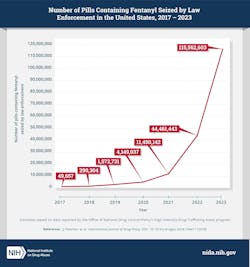Over 115 million pills containing illicit fentanyl seized by law enforcement in 2023
Law enforcement seizures of illicit fentanyl increased dramatically in number and size between 2017 to 2023 in the U.S., especially in pill form, according to a new study funded by the National Institutes of Health’s (NIH) National Institute on Drug Abuse (NIDA).
The number of individual pills containing fentanyl seized by law enforcement was 2,300 times greater in 2023 compared to 2017, with 115,562,603 pills seized in 2023 vs. 49,657 in 2017. The proportion of fentanyl pill seizures to the total number of fentanyl seizures more than quadrupled, with pills representing 49% of illicit fentanyl seizures in 2023 compared to 10% in 2017. The study also found a significant increase in the number and weight of fentanyl-containing powder seizures during this time.
Although fentanyl seizures were historically less common in the Western U.S., this analysis found that this region now accounts for most of law enforcement seizures of fentanyl overall, as well as total weight of fentanyl seized. The proportion of fentanyl pill seizures compared to the overall number of fentanyl seizures was also highest in the West, with 77.8% of all law enforcement seizures of fentanyl in the West being in pill form in 2023. These data emphasize the need for continued monitoring of regional shifts in the fentanyl supply, to help inform targeted prevention and public health responses.
While some people knowingly consume fentanyl, many people do not know if the drugs they plan to use contain fentanyl. This is especially true of illicit counterfeit pills, which are often made to resemble prescription medications such as oxycodone or benzodiazepines, but really contain fentanyl. Recent studies have reported a dramatic rise in overdose deaths among teens between 2010 to 2021, which remained elevated well into 2022 according to a NIDA analysis of CDC and Census data. This increase in deaths has been largely attributed to widespread availability of illicit fentanyl, the proliferation of counterfeit pills containing fentanyl, and the ease of purchasing pills through social media.
The data used for this analysis were collected through the High Intensity Drug Trafficking Areas (HIDTA) program, a grant program aimed at reducing drug trafficking and misuse administered by the Office of National Drug Control Policy. Though law enforcement seizures do not necessarily reflect prevalence of use, they represent an indicator of the availability of illicit drugs.

